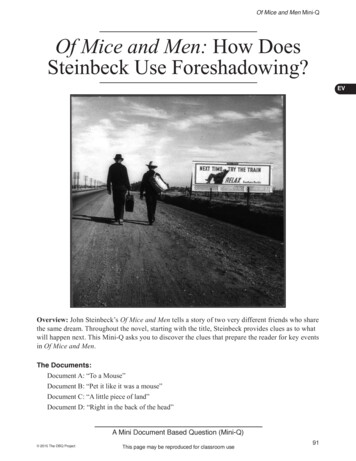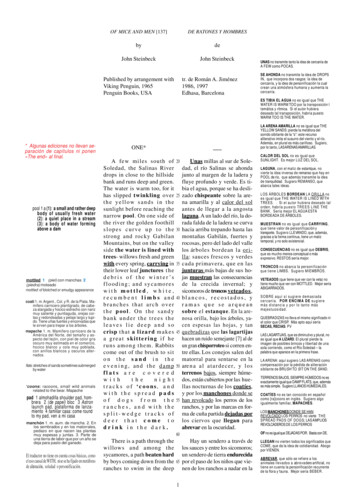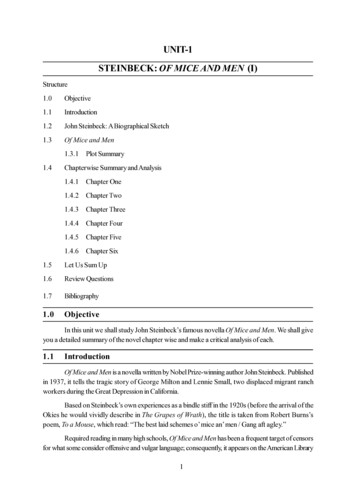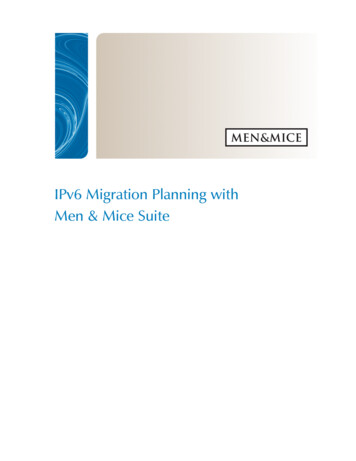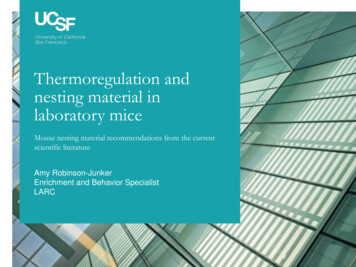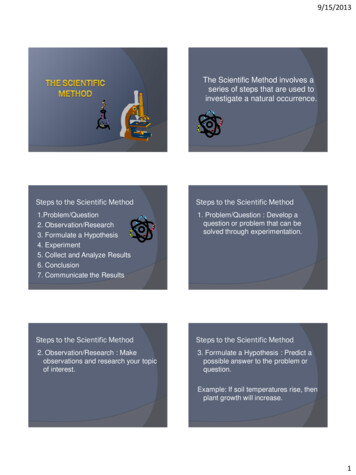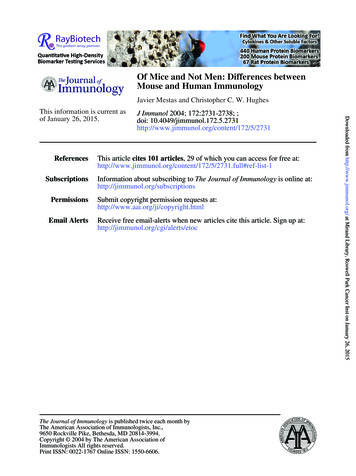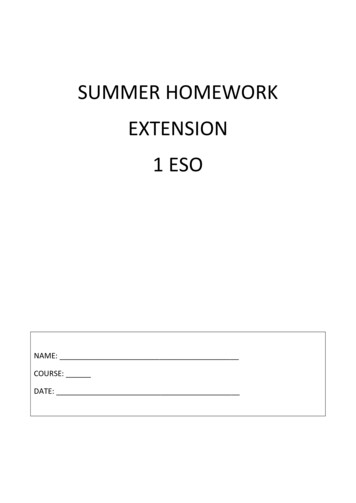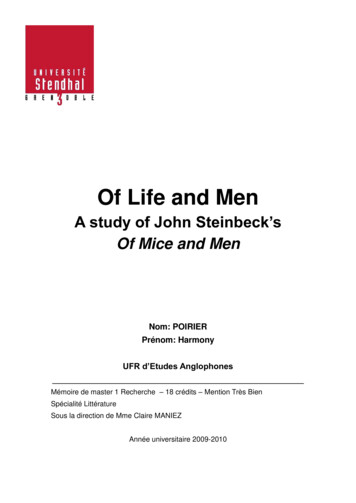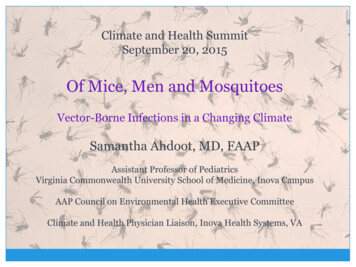
Transcription
Climate and Health SummitSeptember 20, 2015Of Mice, Men and MosquitoesVector-Borne Infections in a Changing ClimateSamantha Ahdoot, MD, FAAPAssistant Professor of PediatricsVirginia Commonwealth University School of Medicine, Inova CampusAAP Council on Environmental Health Executive CommitteeClimate and Health Physician Liaison, Inova Health Systems, VA
Financial DisclosureI have no relevant financial relationshipin relation to this presentation.
“One Health” Climate change is causing shifts in natural systems. The range, life cycle, growing pattern and diseasedynamics of many living organisms are affected bychanging climate conditions. Human health is inextricably linked to the health ofanimals, plants and ecosystems. “One health” encapsulates this interrelatedness.(Little, SE. Veterinary Parasitology, 2013)
“One nimalLifeCyclesPrecipitationPatterns
Climate Change and Infectious Diseases Multiple confounding variables. Impacts of human activitiessuch as land development,travel, time outdoors, airconditioning, self protection. Much easier to identify climatesignal in wildlife disease. Changes in climate influencehabitat suitability andreproductive rate for host,vector, and infectious organismof some infectious diseases.Animal-parasite interactions for whichfield or experimental studies have linkedclimate change to altered disease risk.Altizer S, Science, 2013
Climate Change and Vector-Borne Diseases Lyme Disease West Nile Virus Dengue Fever Chikungunya
Lyme DiseasePhoto Credit:CDC.gov Caused by the spirochete bacteriaBorrelia burgdorferi. Transmitted by the IxodesScapularis tick in the northeastern,northcentral and mid-Atlanticregions, and by the Ixodespacificus tick on the Pacific Coast.Early Signs and Symptoms(3-30 days post tick bite) Fever, chills, fatigue and ErythemaMigrans rash in 70-80% patients.Later Signs and Symptoms(days to months post tick bite) Multiple EM rashes, meningitis, Bell’sPalsy, carditis, arthritis
Lyme Disease Affects about 300,000 people yearly (CDC). Boys 5-9 years at greatest risk. Below threshold temperature, tick mortality outstripsreproduction and populations die out or failto become established (Basic Reproductive Numberor R0 1).Source: phil.cdc.gov Northward expansion of Ixodes Scapularis has been documented in NorthAmerica. This has occurred coincident to, or after, rise in temperature in theseregions, but not before.(Ogden, Int J Health Geogr 2008; Ogden, Environ Health Perspect 2014)
Ixodes Scapularis in North AmericaRising R0 1970-2070R0 increased from 2-3(1970’s) to 4 by 2000’sR0 1.5 1970’s, 2.5 by 2000’sR0 1 1970’s, 1 by 1990’sR0 1.5 1970’s, 2.5 by 2000’sR0 remained 1 throughoutR0 3 1970’s, 3.5 1999No significant changeSource: Ogden, Envir Health Perspect, 2014
Northward Range Expansion Color scale represents the R0 for IxodesScapularis tick. With warming, habitat suitable forIxodes Scapularis tick populationestablishment (R0 1) expandsNorthward.A) estimated from observations1971-2000B) Projected for 2011-2040C) Projected for 2041-2070Source: Ogden, Envir Health Perspect, 2014
Lyme Disease in the U.S.Among the states where Lyme disease is most common, New Hampshire and Delawarehave experienced the largest increases in reported cases since 1991, followed by Maine,Vermont, and Massachusetts.
West Nile Virus The most prevalent flavivirus in the world. Carried primarily byCulex mosquitoes. Likely evolved in Africa. First isolated in 1937 in Uganda. 1950’s-1980’s spread to Middle East, India and Australia. Morefrequent outbreaks started in 1990’s. First detected in U.S. in 1999 in New York City, by 2004 hadspread across contiguous United States, then to Canada andLatin America. Human case numbers highly variable year to year.Smith JC, Journal of Infection 2014, Harrigan RJ, Global Change Biology 2014, Wimberly MC, Am J Trop Med Hyg 2014
West Nile VirusTransmissionSigns and Symptoms Most commonly transmitted to No symptoms (70-80%) Febrile illness (about 20%)humans by mosquitoes (espCulex). Additional routes of humaninfection have also beendocumented, but represent a verysmall proportion of cases: Blood transfusionsOrgan transplantsExposure in a laboratory settingFrom mother to baby duringpregnancy, delivery, orbreastfeeding Fever, headache, body aches, jointpains, vomiting, diarrhea, or rash.Fatigue and weakness can last forweeks or months but completerecovery usual. Severe symptoms ( 1% ) Encephalitis or meningitis, withheadache, high fever, neckstiffness, disorientation, coma,seizures, or paralysis.Recovery may take several weeksor months or may be permanent.Fatal in about 10 percent of peoplewith neurologic infection.
West Nile and Climate Variables Elevated temperature has positive effect on mosquitopopulation, survival, viral replication and WNV diseasetransmission. (Anyamba A, PLoS One 2014)Rate of virus replication for WNV and other viruses, as afunction of temperature, in 2 Culex host mosquito sp.Reisen WK, Journal of Medical Entomology 2006
West Nile and Climate VariablesReisen WK, Journal of Medical Entomology 2006 Temperature has impacted the dispersal and amplification ofWest NileVirus (WNV) in North America. WNV always dispersed into new areas during years with abovenormal (30-yr mean) summer temperatures and amplification thefollowingyear occurred during summers with above-or normaltemp. Activity decreased during cool summers (especially at northernlatitudes).
West Nile Virus Drought may also be associated with increaseddisease activity.2012 outbreak in Southcentral US: One of most severe on record, with 5,674 cases, 2,873 casesneuroinvasive disease and 286 deaths. (CDC) Occurred during historic drought, precipitation lower thanduring Dust Bowl, and extreme high temperatures.(Little SE, Veterinary Parasitology 2013)
Figure 5. Global distribution of epidemics/epizootics of vector-borne disease outbreaksduring 2010–2012 associated with weather extremes, showing the outbreak locations ofWest Nile virus disease (US, 2012), dengue (East Africa, 2011), Rift Valley fever (SouthernAfrica, 2011), and Murray Valley encephalitis (Australia, 2011).Anyamba A, Small JL, Britch SC, Tucker CJ, Pak EW, et al. (2014) Recent Weather Extremes and Impacts on Agricultural Productionand Vector-Borne Disease Outbreak Patterns. PLoS ONE 9(3): e92538. 081/plosone/article?id info:doi/10.1371/journal.pone.0092538
A continental risk assessment of West Nile virus under climate changeGlobal Change BiologyVolume 20, Issue 8, pages 2417-2425, 27 FEB 2014 DOI: i/10.1111/gcb.12534/full#gcb12534-fig-0005
Dengue Fever and ChikungunyaDengue Likely originated in Africa or Asia. Most prevalent and rapidly spreadingmosquito-borne viral disease in theworld (400 million yearly per CDC). One of leading causes ofdeath/hospitalization of children intropics. 50% asymptomatic. Symptoms include high fever, severeheadache/eye pain, muscle/bone pain,rash, may be followed by hemorrhagicmanifestations.Chikungunya First described in 1952 in Africa, but likelycaused periodic outbreaks in tropicalregions for centuries. Word translates to “to walk bent over”,due to severe joint pain. Symptoms include acute fever, muscle andjoint pain, nonspecific rash. Only 4%asymptomatic. 20% patients have severe, recurrent jointpains after 1 year. Case fatality ratio 1 per 1000, primarily innewborns, elderly and debilitated.(Morens DM, NEJM 2014)(Sirisena P, International Journal of Inf Dis 2014)
Aedes Mosquitoes Primary vectors for both Dengue and Chikungunya. Aedes aegypti (classic vector) and Aedes albopictus (Asian TigerMosquito). Chikungunya acquired mutations in 2004 that enabled it to betransmitted by Ae. albopicutus. Have adapted to sub-urban/rural areas where humans are present.
Role of Climate Factors The impacts of climate on these diseases are complex and incompletelyunderstood. Both minimum and maximum temperatures limit mosquitodevelopment and survival. Increased temperature shortens mosquito development times, thoughthis differs for tropical/temperate mosquito strains. Climate change can expand vector range, extend the transmissionseason, shorten the mosquito life cycle and reduce time to mosquitoinfectivity.(Sirisena P, International Journal of Inf Dis, 2014) Effects of precipitation on mosquito populations are incompletelyunderstood. (Waldock, J. Pathogens and Global Health, 2013)
Effect of temperature on Aedes albopictus immature developmentWaldock J, Pathogens and Global Health 2013
Climate Factors and DengueEstimated effects of weather variables on Dengue incidencein Mexico over 23 years. (Colon-Gonzalez, PLOS Neglected Tropical Diseases 2013)
“One Health” The health of humans, animals, and ecosystems areinextricably linked. Vector-borne infections are central to “One Health”. Further understanding of these complex relationships isneeded to enable communities and health systems toeffectively prepare for and control these rising healththreats.
Climate Change and Child HealthResources: American Academy of Pediatrics-Global Climate Change and Children’s Health. Policy Statement and Tech Report, 2007.Climate Change, Challenges and Opportunities for GlobalHealth. JAMA, 2014.American Public Health Association– Climate ChangeUNICEF- Climate Change and ChildrenWHO- Climate Change and Human HealthLancet Commission on Climate Change and HealthNational Climate Assessment , GlobalChange.govNASA- climate.nasa.gov NOAA- noaa.gov/climate.html
Lyme Disease Affects about 300,000 people yearly (CDC). Boys 5-9 years at greatest risk. Below threshold temperature, tick mortality outstrips reproduction and populations die out or fail to become established (Basic Reproductive Number or R 0 1). Northward expansion of Ixodes Scapularis has been documented in North America. This has occurred coincident to, or after, rise in temperature in these
